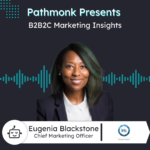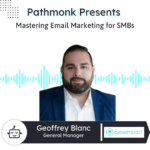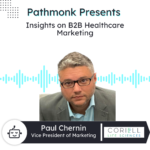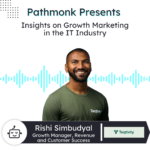SaaS
Introduction
Karl Gowens is the CEO of Tenon. Tenon aims to build the best accessibility testing tools on the market. Tenon is built to lead the way in accessible user experiences. Karl has over a decade experience in doing IT consulting for the biggest companies in the world and biggest agencies in the US Government and shows us how to to shorten time from visit to website lead.
He is an unstoppable force for change and thought-leader offering solutions to complex problems relating to universal usability. Today we speak about how Accessibility affects the website experience and conversions and how he is continously shortening time from website visit to registration…
See how to grow shorten time from website visit to website lead
Pathmonk: We’ve been speaking with a lot of folks here on conversion rate optimization on websites, have you seen any connection of accessibility and conversion rate? So do you have any experience on that, on that, on that side?
Karl Groves: So there’s a lot of, there’s a lot of talk around this kind of topic that’s been going on for a long time. And, uh, one of the biggest examples that’s out there is a case study around legal in general in the UK and legal in general, had spent, spent a lot of time on improving the overall usability of their site and that also included a lot of accessibility, improvements and the numbers that they have (…) people sometimes think, if you make it accessible, it’s going to be more SEO friendly and all that sort of stuff and it’s going to be more mobile friendly and those sorts of things. And that those also have their own intrinsic benefits. But I think there’s a missed opportunity when it comes to accessibility when it comes to capturing a new audience entirely. So in other words, you make your website that wasn’t accessible, you make it more accessible and then the part that people forget is they need to market to the people with disabilities, users with disabilities are extremely loyal customers. Once they find a website or a product that they can use easily there, they’re not going anywhere, right? Because the options are pretty abysmal when it comes to accessibility. Accessibility is kind of bad on the web. And so if somebody with a disability finds, like I said, finds a product or service that’s really accessible for them, they’re going to go there, they’re going to tell their friends about it, and that’s where you’re going to get a lot of good ROI.
Pathmonk: Do you have a percentage guess on what products or pages are accessible versus aren’t, is there some stats around that out there?
Karl Groves: Yeah. Well we’ve done, we’ve assessed about 6 million web pages on our product. And we can say without fail that about maybe 1% of pages on the web are error free, completely error free. Now that doesn’t mean that that, you know, there, there can be probably millions of those pages that are usable. Like you know, people can actually use them but they’re still gonna have errors on them. So that’s kind of the hard part about gathering the data automatically is we don’t have the we don’t have the qualitative data of determining like what the, what the delta is between something that has errors but is still usable versus something that’s not.
Pathmonk: Like what would be a typical user journey for somebody to discover the product and get started?
Karl Groves: We’ve been really really lucky. So prior to me founding Tenant, I was also a very active blogger and speaker. And so I generated a lot of brand awareness for myself before I started. So almost 100% of our business is inbound and it’s either inbound based upon personal reputation or inbound based upon now that the product is getting its own, his own reputation and stuff like that. So we do very minimal advertisement. A lot of our, um, a lot of our quote unquote marketing efforts are based on either speaking appearances by me or additional blogs or other knowledge marketing kind of activities.
Pathmonk: Maybe you can give the listeners one tip or insight into how were you able to build that personal brand? Like how did that, if you would give somebody one tip on hand on, you know, become somebody to actually be on the stage and talk about their topic, what would you give them as an advice?
Karl Groves: Well, I think that, I think that knowledge share is really the way to go when it comes, especially to our industry and probably to any other tech industry if you’re selling, if you’re selling a technical product or services is sharing your knowledge. For me it’s been very huge way to build that brand because basically, no matter where you are in your career, there’s always going to be somebody earlier in their career and they’re going to need to learn their need to, they’re going to need to learn what they’re doing. They’re going to need to learn the tips and tricks of experts. And so if you can share that stuff by being involved in social media, being involved in appearances at your relevant conferences and also writing blog posts and things like that, I think that’s, I think that’s been one of the biggest things for me in terms of generating that awareness. And I think that, you know, you’re doing, you’re doing two things, right? You’re, you’re marketing of course, but you’re also helping to, uh, improve the experiences of others who are still trying to get to where you are.
Pathmonk: Could you tell me a little bit about your own website? What role does the website play in the overall marketing.
Karl Groves: The website actually it’s, it’s kind of interesting you said that because we about six, seven months ago, we released a new version of the homepage because our homepage that we had before was terrible at selling. It didn’t explain what the product was. It didn’t explain what we did or how we did it or anything like that.It was just like, here’s a box, try out our product. There you go., and since then we’ve gone through a redesign process that also includes the product itself. But the first part that we’ve unveiled so far has been the, has been the homepage. And that’s really sort of your first opportunity to tell people who you are and what you’re, what you’re about and how you do it. And so we were very diligent about explaining the three aspects of testing, training, and tooling. The idea that, um, all with, with all three of these, you can get closer to solving your accessibility problems.
Pathmonk: Which metrics do you care about on the website?
Karl Groves: Well the only thing I care about is whether they’ve converted to a customer or not. The things that I care about is some of the, some of the actions that people are taking, especially in terms of how that funnel works from a person becoming a visitor to maybe using the free demo widget that we have on the site to them registration and then and the metrics they’re like, one of the metrics I calculate is the distance between first visit and registration because I want to shorten that? Right I mean in all cases you want to shorten the distance between the time the person registers, the time they give you money. And so that that track between the first visit to the, to the registration and then of course from the registration to the purchase as well. One of the things that I focus primarily on is that first visit to registration metric. That’s one of the things I want to shorten as much as possible (…)












